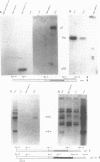Abstract
The sparse fur with abnormal skin and hair (Spf-ash) mouse is a model for the human X-linked hereditary disorder, ornithine transcarbamylase (OTC) deficiency. In Spf-ash mice, both OTC mRNA and enzyme activity are 5% of control values resulting in hyperammonemia, pronounced orotic aciduria and an abnormal phenotype characterized by growth retardation and sparse fur. Using microinjection, we introduced a construction containing rat OTC cDNA linked to the SV40 early promoter into fertilized eggs of Spf-ash mice. The expression of the transgene resulted in the development of a transgenic mouse whose phenotype and orotic acid excretion are fully normalized. Thus, the possibility of correcting hereditary enzymatic defect by gene transfer of heterologous cDNA coding for the normal enzyme has been demonstrated.
Full text
PDF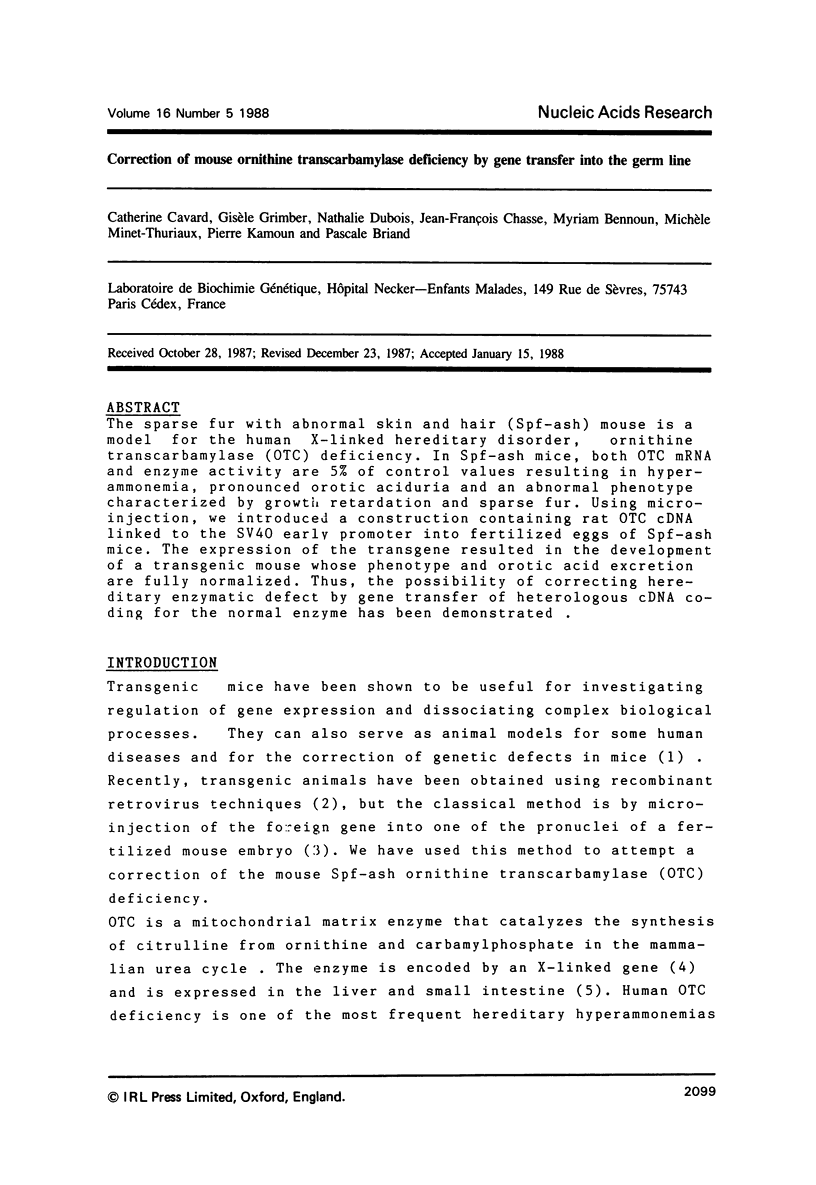
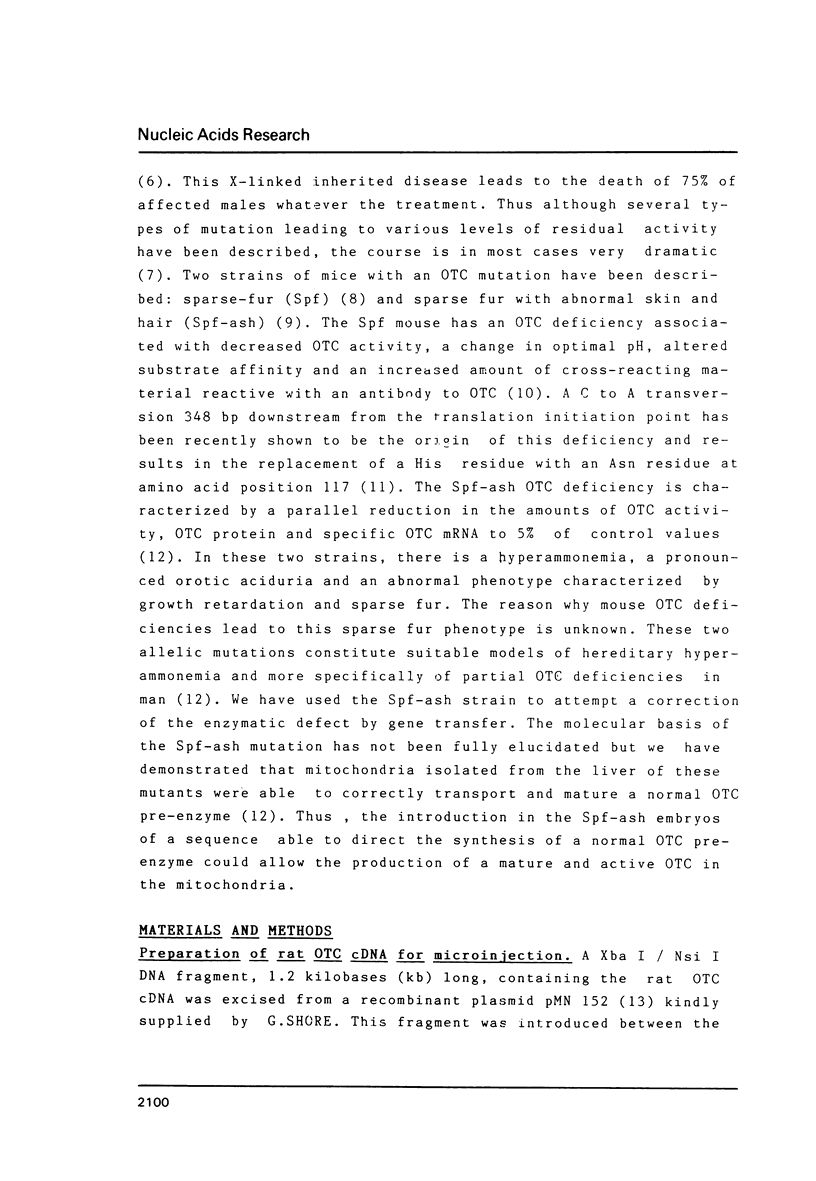




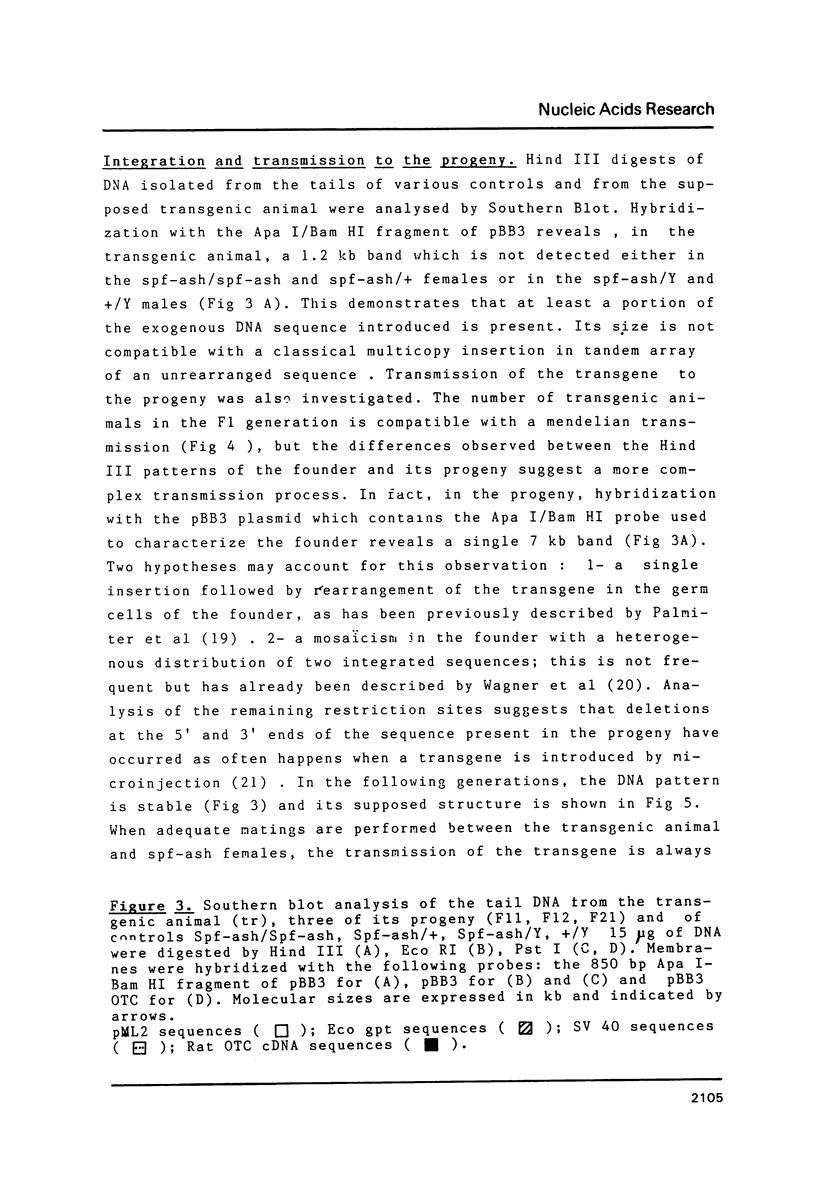
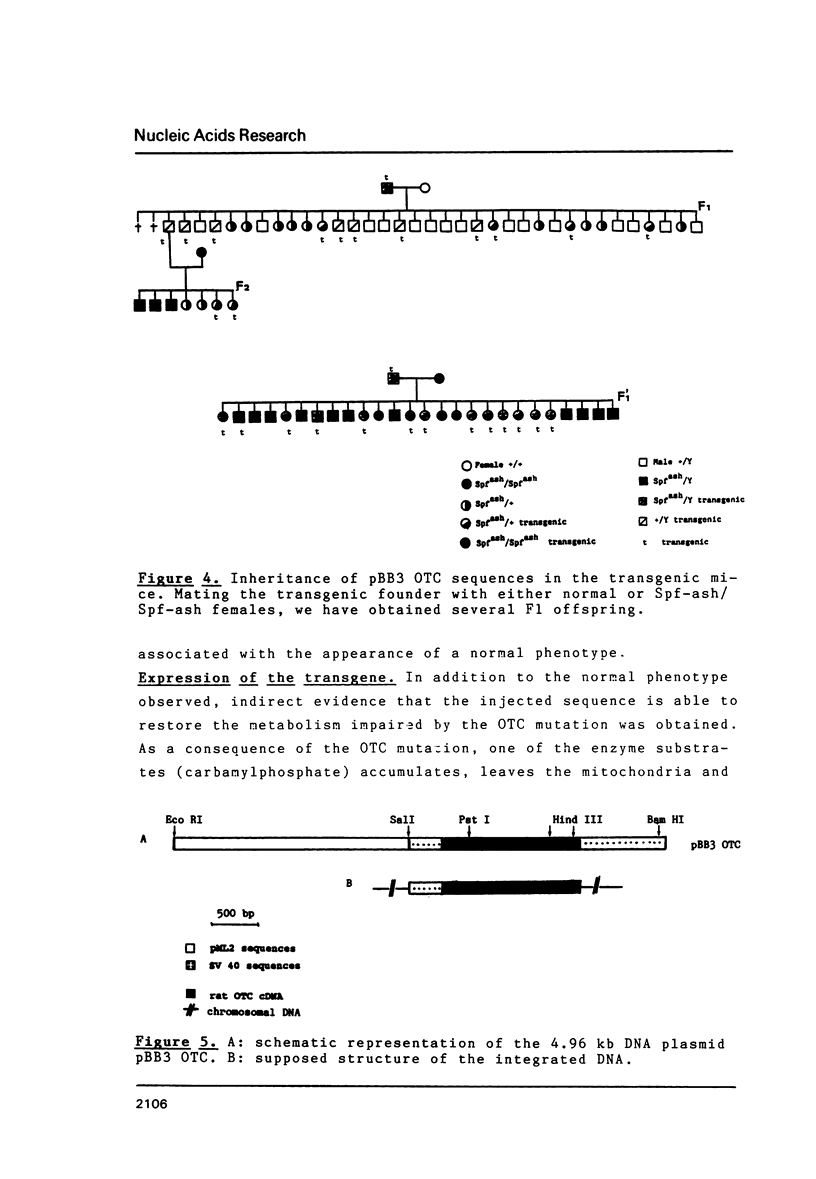
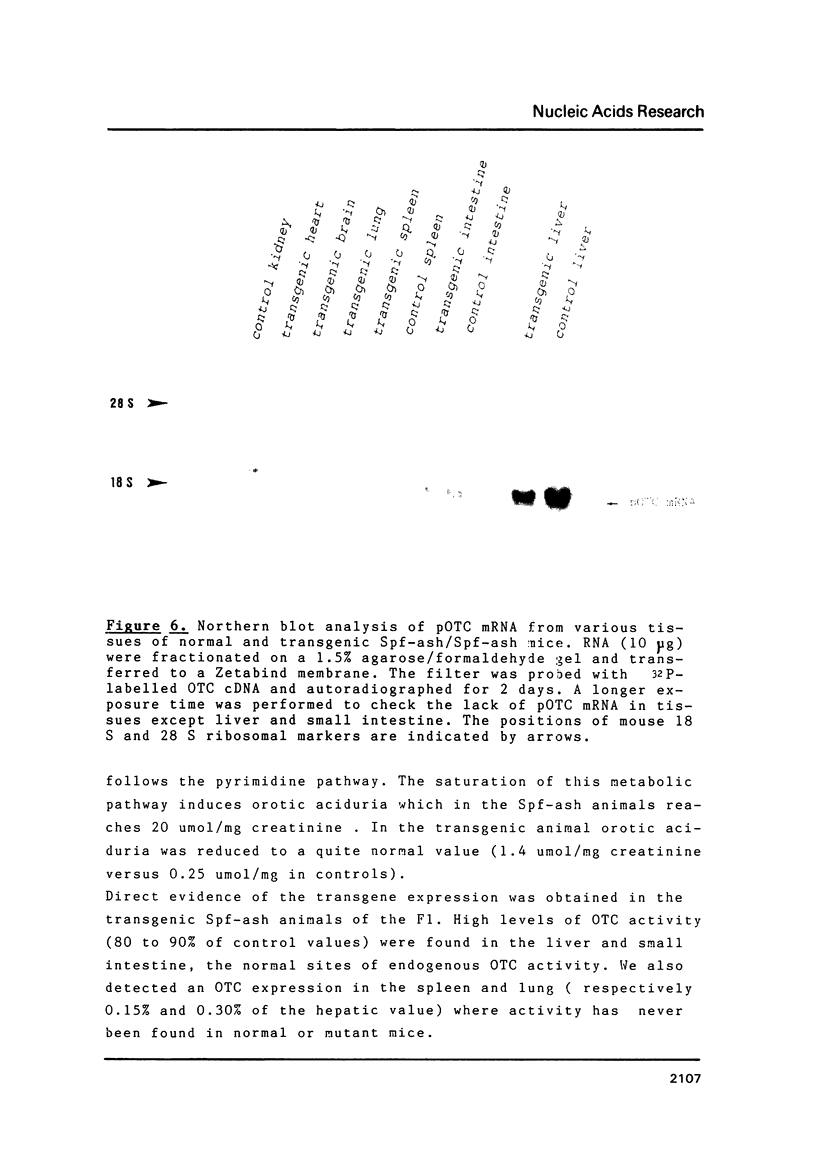
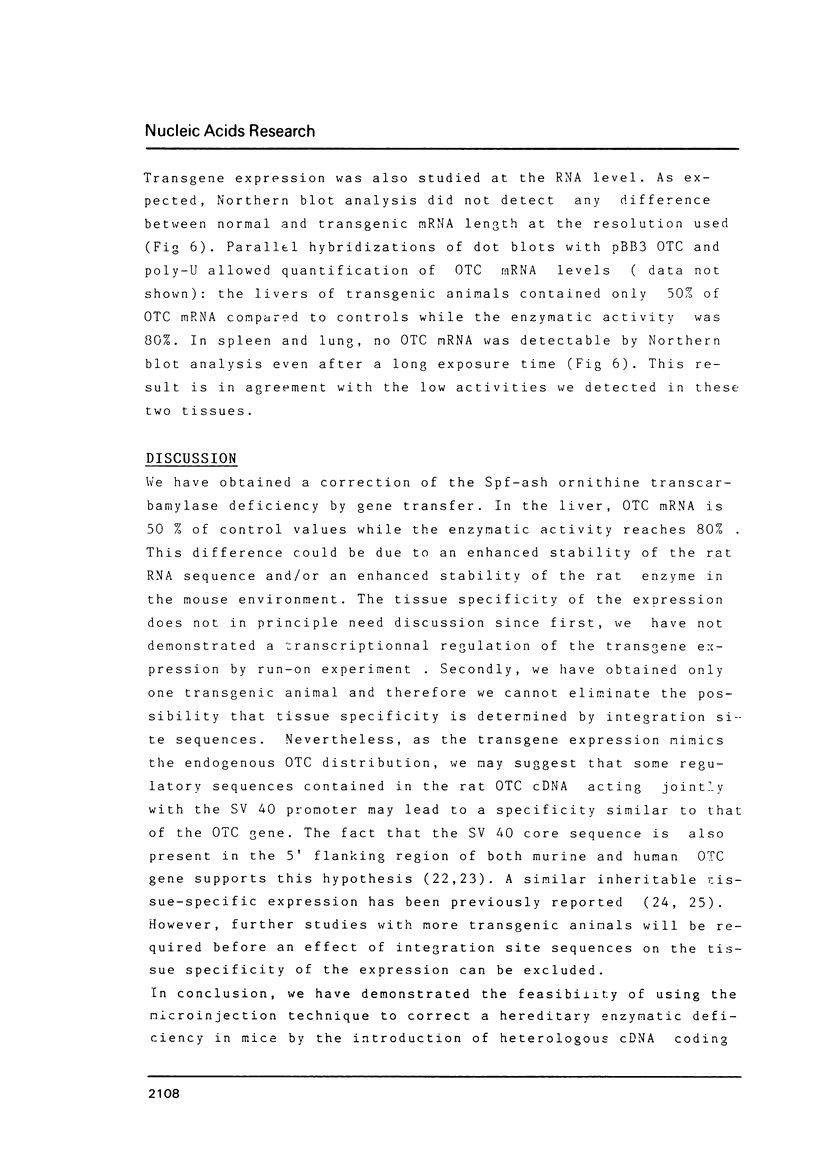


Images in this article
Selected References
These references are in PubMed. This may not be the complete list of references from this article.
- Bourachot B., Jouanneau J., Giri I., Katinka M., Cereghini S., Yaniv M. Both early and late control sequences of SV40 and polyoma promote transcription of Escherichia coli gpt gene in transfected cells. EMBO J. 1982;1(8):895–900. doi: 10.1002/j.1460-2075.1982.tb01268.x. [DOI] [PMC free article] [PubMed] [Google Scholar]
- Briand P., Cathelineau L., Kamoun P., Gigot D., Penninckx M. Increase of ornithine transcarbamylase protein in sparse-fur mice with ornithine transcarbamylase deficiency. FEBS Lett. 1981 Jul 20;130(1):65–68. doi: 10.1016/0014-5793(81)80666-7. [DOI] [PubMed] [Google Scholar]
- Briand P., Miura S., Mori M., Cathelineau L., Kamoun P., Tatibana M. Cell-free synthesis and transport of precursors of mutant ornithine carbamoyltransferases into mitochondria. Biochim Biophys Acta. 1983 Nov 8;760(3):389–397. doi: 10.1016/0304-4165(83)90379-3. [DOI] [PubMed] [Google Scholar]
- DeMars R., LeVan S. L., Trend B. L., Russell L. B. Abnormal ornithine carbamoyltransferase in mice having the sparse-fur mutation. Proc Natl Acad Sci U S A. 1976 May;73(5):1693–1697. doi: 10.1073/pnas.73.5.1693. [DOI] [PMC free article] [PubMed] [Google Scholar]
- Doolittle D. P., Hulbert L. L., Cordy C. A new allele of the sparse fur gene in the mouse. J Hered. 1974 May-Jun;65(3):194–195. doi: 10.1093/oxfordjournals.jhered.a108500. [DOI] [PubMed] [Google Scholar]
- Gordon J. W., Ruddle F. H. Gene transfer into mouse embryos: production of transgenic mice by pronuclear injection. Methods Enzymol. 1983;101:411–433. doi: 10.1016/0076-6879(83)01031-9. [DOI] [PubMed] [Google Scholar]
- Hata A., Tsuzuki T., Shimada K., Takiguchi M., Mori M., Matsuda I. Isolation and characterization of the human ornithine transcarbamylase gene: structure of the 5'-end region. J Biochem. 1986 Sep;100(3):717–725. doi: 10.1093/oxfordjournals.jbchem.a121764. [DOI] [PubMed] [Google Scholar]
- Jackson M. J., Beaudet A. L., O'Brien W. E. Mammalian urea cycle enzymes. Annu Rev Genet. 1986;20:431–464. doi: 10.1146/annurev.ge.20.120186.002243. [DOI] [PubMed] [Google Scholar]
- Kamoun P., Coudé M., Deprun C., Rabier D. Source of error in the assay of urinary orotic acid. Clin Chem. 1987 May;33(5):713–713. [PubMed] [Google Scholar]
- Möröy T., Etiemble J., Trépo C., Tiollais P., Buendia M. A. Transcription of woodchuck hepatitis virus in the chronically infected liver. EMBO J. 1985 Jun;4(6):1507–1514. doi: 10.1002/j.1460-2075.1985.tb03810.x. [DOI] [PMC free article] [PubMed] [Google Scholar]
- Nguyen M., Argan C., Lusty C. J., Shore G. C. Import and processing of hybrid proteins by mammalian mitochondria in vitro. J Biol Chem. 1986 Jan 15;261(2):800–805. [PubMed] [Google Scholar]
- Palmiter R. D., Brinster R. L. Germ-line transformation of mice. Annu Rev Genet. 1986;20:465–499. doi: 10.1146/annurev.ge.20.120186.002341. [DOI] [PMC free article] [PubMed] [Google Scholar]
- Palmiter R. D., Brinster R. L. Transgenic mice. Cell. 1985 Jun;41(2):343–345. doi: 10.1016/s0092-8674(85)80004-0. [DOI] [PubMed] [Google Scholar]
- Palmiter R. D., Wilkie T. M., Chen H. Y., Brinster R. L. Transmission distortion and mosaicism in an unusual transgenic mouse pedigree. Cell. 1984 Apr;36(4):869–877. doi: 10.1016/0092-8674(84)90036-9. [DOI] [PubMed] [Google Scholar]
- Raijman L. Citrulline synthesis in rat tissues and liver content of carbamoyl phosphate and ornithine. Biochem J. 1974 Feb;138(2):225–232. doi: 10.1042/bj1380225. [DOI] [PMC free article] [PubMed] [Google Scholar]
- Short E. M., Conn H. O., Snodgrass P. J., Campbell A. G., Rosenberg L. E. Evidence for x-linked dominant inheritance of ornithine transcarbamylase deficiency. N Engl J Med. 1973 Jan 4;288(1):7–12. doi: 10.1056/NEJM197301042880102. [DOI] [PubMed] [Google Scholar]
- Snodgrass P. J. The effects of pH on the kinetics of human liver Ornithine--carbamyl phosphate transferase. Biochemistry. 1968 Sep;7(9):3047–3051. doi: 10.1021/bi00849a004. [DOI] [PubMed] [Google Scholar]
- Soriano P., Cone R. D., Mulligan R. C., Jaenisch R. Tissue-specific and ectopic expression of genes introduced into transgenic mice by retroviruses. Science. 1986 Dec 12;234(4782):1409–1413. doi: 10.1126/science.3024318. [DOI] [PubMed] [Google Scholar]
- Swanson L. W., Simmons D. M., Arriza J., Hammer R., Brinster R., Rosenfeld M. G., Evans R. M. Novel developmental specificity in the nervous system of transgenic animals expressing growth hormone fusion genes. 1985 Sep 26-Oct 2Nature. 317(6035):363–366. doi: 10.1038/317363a0. [DOI] [PubMed] [Google Scholar]
- Veres G., Craigen W. J., Caskey C. T. The 5' flanking region of the ornithine transcarbamylase gene contains DNA sequences regulating tissue-specific expression. J Biol Chem. 1986 Jun 15;261(17):7588–7591. [PubMed] [Google Scholar]
- Veres G., Gibbs R. A., Scherer S. E., Caskey C. T. The molecular basis of the sparse fur mouse mutation. Science. 1987 Jul 24;237(4813):415–417. doi: 10.1126/science.3603027. [DOI] [PubMed] [Google Scholar]
- Wagner E. F., Covarrubias L., Stewart T. A., Mintz B. Prenatal lethalities in mice homozygous for human growth hormone gene sequences integrated in the germ line. Cell. 1983 Dec;35(3 Pt 2):647–655. doi: 10.1016/0092-8674(83)90097-1. [DOI] [PubMed] [Google Scholar]
- Wilkie T. M., Palmiter R. D. Analysis of the integrant in MyK-103 transgenic mice in which males fail to transmit the integrant. Mol Cell Biol. 1987 May;7(5):1646–1655. doi: 10.1128/mcb.7.5.1646. [DOI] [PMC free article] [PubMed] [Google Scholar]




